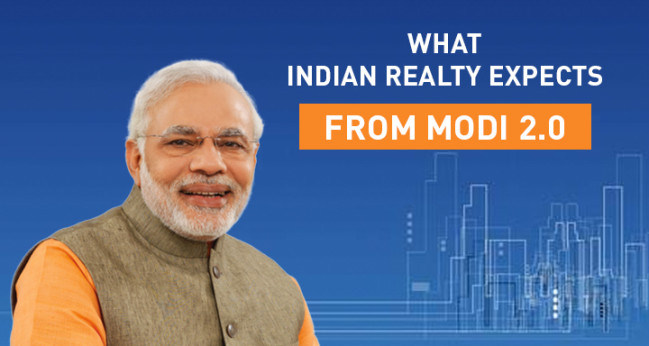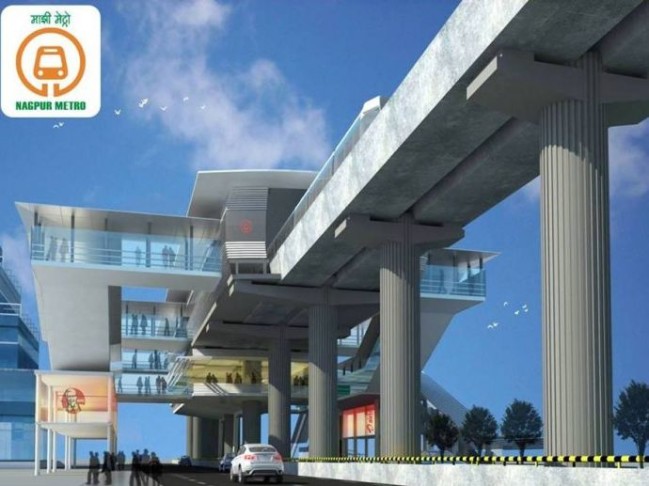Real Estate Sector’s Expectations from Modi 2.0
Modi 2.0: Real Estate Expectations
The NDA led by Narendra Damodar Das Modi came to power in 2014 with a promise to overturn the dynamics in India. Modi is the 2nd Prime Minister from the Other Backward Caste (OBC) category, who has brought actions to remove the socio-economic backwardness of citizens, which had been paralyzed or played down by governments in the past. Several new schemes and initiatives have been launched till now and some of the old schemes have been restructured or extended seeking their progress.
The real state sector has been struggling over the past few years with high inventory pile up, price inactivity, decreasing sales numbers, and so on. The current government has taken a lot of initiatives starting from passing of the RERA (real estate regulatory authority) Bill in 2016, Benami Transactions (Prohibition) Act, giving interest subsidy for affordable houses under Pradhan Mantri Awas Yojana under the “Housing for All” scheme of the government, implementation of the Goods and Services Tax (GST), and Insolvency and Bankruptcy Code, etc. But there is a lot more that needs to be done as the real sector is yet to see improvement. The recent NBFC crisis may further mark the recovery of the sector if the government misses taking some immediate action.
Here is a list of the Revolutionary steps taken by Modi Govt. to boost Indian Economy:
India got a boost under Modi’s rule in the real estate sector. He launched the “Make in India” project to bring global investment in India. The govt also changed “Foreign Direct Investment” in 25 sectors. This resulted in a rise in India’s rankings in the “ease of doing business” of the World Bank, the World Economic Forum’s “Global Competitiveness Index” and in the “Logistics Performance Index”. This movement also supported India’s other project such as Bharatmala, Sagarmala, Industrial corridors, UDAN-RCS, Dedicated Freight Corridors, Bharat Broadband Network, and Digital India.
The government encouraged young entrepreneurs to suggest new ideas with the help of the government. The government started a flagship program ‘Startup India’, which intended to grow startups in the country. The government relaxed measures to start businesses, set up provision centers and made tax exemptions possible to those aspiring to establish startups.
Implementation of the Pradhan Mantri Mudra Yojana:
The Pradhan Mantri Mudra Yojana is another initiative of the Modi government. Under Mudra Yojana, small-scale enterprises get 100% of the funds to start businesses with untroubled sessions. Company of small and micro businesses has created jobs in both urban and rural India.
Implementation of GST:
We all know that the bill for a single tax all over the country was stuck in Parliament for years but ignored due to some difficulties. The Modi led NDA government passed the GST bill after continuous consultations with all stakeholders and brought it into effect.
There was a lot of confusion in the beginning but later the government simplified the slabs and methods of paying the Goods and Service Tax. And to manage a periodical review of the effectiveness of the tax regime and to take steps for its significant implementation, the government established the GST Council.
Expansion and construction of roads and highways:
The pace of road construction has also increased than previous. Now, 40 km roads are constructed each day, which is double the number under the previous government (14 km).
Crackdown on Black Money:
Special Investigation Team (SIT) and powerful black money law passed, including rigorous imprisonment to fast-track action against tax defaulter.
Ease of Doing Business:
Initially, one has to take permission and pay bribe from several departments to start a business. Under this, Investor Facilitation Cell, an e-biz portal for single online returns filing, reduction in import-export formalities, de-licensing and de-regulating of industry.
Make In India:
Soon after taking charge, on September 25, 2014, Modi govt commenced the drive to attract foreign investment and build brand India. The main purpose behind this policy was to make India a global manufacturing hub, by encouraging both multinational as well as domestic companies to manufacture their products within the country.
Demonetization:
The Prime Minister’s sudden decision on November 8 for removing most of the black money inflow and left millions struggling for cash. It was intended at stopping untaxed or black money.
Smart Cities Mission:
Urban modification and rehabilitation program to make 100 shortlisted cities across the country. Government of India announced the first 20 smart cities under ‘Smart Cities Mission’. The list has been released out of the 100 shortlisted cities. This scheme got a grant of Rs.980 billion from the Indian Cabinet for the renovation of 500 cities.
Missions for Smart Cities and Urban Transformation (AMRUT) got Rs.98000 crore from Modi-led government.
National Bamboo Mission:
This mission has been restructured by the government in the Union Budget 2018 with a concept to support commercial bamboo farming in the northeastern states to increase the income of the bamboo farmers. There is a plan of appropriating this mission under the Pradhan Mantri Awas Yojana, the government’s flagship program for housing to build up bamboo homes.
Loans at Fingertips for MSMEs:
Modi government published this scheme for the Micro, Small, and Medium Enterprises (MSMEs). As per this scheme, the eligible companies can get loans up to Rs.1 Crore and it will be approved within an hour. The Modi govt’s intention through this scheme is to boost the MSME sector of the country as it is an important one which shares its contributes towards the economy.
Insolvency and Bankruptcy Code:
The Modi govt can stroke itself on the back for implementing a comprehensive bankruptcy law, India’s own version of the Section 11 law in the US Bankruptcy Code. Ever since its implementation in 2016 though, the IBC has been the subject of legislative and regulatory adjustment by parliament, the Insolvency, and Bankruptcy Board of India and the Reserve Bank of India.
The Benami Transactions (Prohibition) Amendment Act:
The 1988 Benami Property Transactions Act was ineffective as it has no powers of a civil court, no special plans for the settling of seized or illegal property, no appellate structure set. The Benami Transactions (Prohibition) Amendment Act is operational since 1st November 2016, enables authorities to provisionally add and finally seize benami properties. It also gives jail terms of between 1-7 years and a penalty that can be up to 25% of the fair market value of the property.
The Real Estate (Regulation and Development) Act, 2016:
The introduction of the Real Estate (Regulation and Development) Act. One of the remarkable and extreme differences in India’s policymaking has been around real estate. We hope that policies introduced in the past session, like GST and RERA, are seen within and executed smoothly in this term. We hope that the new government sets the economy at the forefront and proceeds to achieve improvements in the realty sector, by generating jobs and increasing growth.
Foreign Investment and Policy Reforms:
Foreign direct investments have increased since BJP came to power. The government had released foreign investment policy in some important sectors, including retail, aviation, and construction. Modi has made numerous foreign tours as Prime Minister with nearly all of the world’s top leaders. He has succeeded in making a meaningful reunion with key neighbors such as China, USA, France, Germany, Rusia, Israel, Afganistan, Dubai, etc.
Apart from that, there are several schemes that have not gone very far. These are:
-
Make in India/Startup India
-
Black Money or Demonetization
-
Bad Loans or Insolvency and Bankruptcy Code
-
Agriculture
Opportunities where NDA Govt can take action:
Direct Tax Code:
After GST, the Direct Tax Code is the other big tax improvement that the Modi government is reportedly studying at executing. With these modifications, Modi intends to bring some happiness to middle-class Indians by reducing their actual tax costs and make corporate houses more competing by decreasing their tax burden.
GDP Growth:
In December 2018, India’s GDP was 7.2% and it improving the tag of the World’s fastest growing economy from China. The Modi government would serve well to try and keep this energy moving.
Infrastructure (Roads/ Railways// Power):
In September 2017, Modi and his Japanese counterpart Shinzo Abe put the foundation stone for the Ahmedabad-Mumbai Bullet Train project, which is to be completed by 2022. This project still needs support from the NDA govt for its successful completion.
What real estate sector hopes from Modi 2.0?
The real estate industry is now fastened hopes of a return on the BJP-led NDA government as the sector remains facing delay housing project, increasing of unsold inventories and the cash crunch that is hitting its source. The target of Housing for All by 2022 also needs an improved push by the government to become a fact.
Indian real estate sector has been the worst hit due to weakening liquidity following the failure of IL&FS and demonetization. Beginning of RERA in 2017 added to the agreement costs for developers. The implementation of GST further added to the pressure for the developers due to silenced sales.
The real estate sector has huge expectation from the new government to improve liquidity, balance financial system with a motive, unaffordable property prices for the largest part of the Indian population, and facilitate analysis of underscored projects and put to rights implementation of RERA without too many changes in regulatory norms.
The industry also wants the new governments to insist on re-energizing the developments related to infrastructure, investment, and land acquisition reforms. They also want to support the National Housing Policy to boost rental housing in order to achieve the challenging target of Housing for All by 2022 by creating excesses.
Faster clearance:
A single window clearance is a long pending demand of the real estate industry in India. Delay in receiving clearances directs to increased cost, which sequentially has to be transferred on to the home buyer. A quicker approval rule with limited documentation will benefit the industry and conclusively the home buyer. It is necessary that single window clearance is soon placed into usage, which will not only fix operational issues common in the industry but would enhance the productivity of the real estate industry.
Input Tax credit under GST:
Recently govt has implemented GST at 5% with the ending of input tax credit again was disturbing for developers as the cost side GST is still expensive and not yet controlled. Therefore, the expectation in new tenure is that the government shall improve input side GST rates to revive the soft margins of developers.
Housing for all by 2022:
The most acknowledge “Housing for All by 2022” initiatives came under question because if it is to succeed, it requires favored exercises from a strong-minded government. This mission could now surely see success if not by 2022, then at least towards the end of this new 5-year cycle.
Start-ups and co-working spaces:
In the last 5 years, start-ups in the real estate sector were responsible for making the concept of co-working spaces a big business. The developers and service providers in the co-working space, now expect more support to such start-ups and tax reforms, to aid their business.



